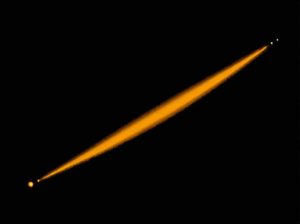When we look up at the night sky, we see stars of varying brightness. Some shine brilliantly, while others are barely visible. But have you ever wondered how dim a star can be? In astronomy, the magnitude system is used to measure the brightness of stars. The dimmest stars have extremely high magnitudes, making them nearly impossible to see without powerful telescopes.
This topic explores the magnitude of the dimmest stars, how astronomers measure their brightness, and what factors influence a star’s visibility.
1. Understanding Stellar Magnitude
A. What Is Apparent Magnitude?
The apparent magnitude of a star refers to how bright it appears from Earth. This scale was developed by Hipparchus, an ancient Greek astronomer, who classified stars into six categories:
- Magnitude 1: The brightest stars in the sky (e.g., Sirius).
- Magnitude 6: The faintest stars visible to the naked eye.
Modern astronomy extends this scale, allowing for negative values for extremely bright objects and much higher values for faint stars.
B. What Is Absolute Magnitude?
Absolute magnitude measures a star’s brightness if it were placed at a standard distance of 10 parsecs (32.6 light-years). This eliminates the effect of distance and provides a true measure of a star’s intrinsic brightness.
2. How Dim Can a Star Be?
A. The Faintest Stars Visible to the Naked Eye
- Under ideal conditions, the dimmest stars visible without a telescope have an apparent magnitude of about 6.5.
- In cities with heavy light pollution, this limit is much lower, around 3 or 4.
B. The Dimmest Stars Seen with Telescopes
With telescopes, astronomers can detect much fainter stars:
- The Hubble Space Telescope can observe stars with magnitudes around 31.
- The James Webb Space Telescope (JWST) can detect even fainter objects.
C. The Dimmest Known Stars
The dimmest stars belong to a class called ultracool dwarfs and white dwarfs:
-
WISE 0855−0714
- One of the faintest known brown dwarfs.
- Apparent magnitude: 26.8 (extremely dim).
-
Van Maanen’s Star
- A white dwarf with an apparent magnitude of 12.4, requiring a telescope to see.
3. Factors Affecting a Star’s Brightness
A. Distance from Earth
- A bright star far away can appear dimmer than a faint star that is close.
- Example: Betelgeuse is bright despite being 640 light-years away, while Proxima Centauri, the nearest star, is much dimmer.
B. Size and Temperature
- Larger and hotter stars emit more light and have lower magnitudes.
- Cooler and smaller stars, like red dwarfs, have higher magnitudes and appear dim.
C. Obscuration by Dust and Gas
- Interstellar dust can block light, making some stars appear dimmer than they actually are.
4. How Astronomers Measure the Dimmest Stars
A. Ground-Based Observations
- Large telescopes, like the Keck Observatory, help detect faint stars.
- Adaptive optics and long exposure times allow astronomers to capture dim objects.
B. Space Telescopes
- The Hubble Space Telescope has observed objects with magnitudes of 30+.
- The James Webb Space Telescope can detect even fainter stars in infrared light.
C. Computer Modeling
- Astronomers use light curve analysis and spectroscopy to estimate the properties of ultra-faint stars.
5. Could There Be Even Dimmer Stars?
A. Black Dwarfs: Theoretical Dimmest Stars
- A black dwarf is a white dwarf that has cooled down so much it no longer emits light.
- However, the universe is not old enough for black dwarfs to exist yet.
B. Rogue Stars in Intergalactic Space
- Some isolated stars in deep space might be undetectable with current technology.
The dimmest stars have extremely high magnitudes, making them invisible without powerful telescopes. The faintest star visible to the naked eye has a magnitude of 6.5, while space telescopes like Hubble can detect stars with magnitudes over 30.
As technology advances, astronomers may discover even fainter stars, helping us understand the boundaries of stellar evolution and the true extent of the universe.



